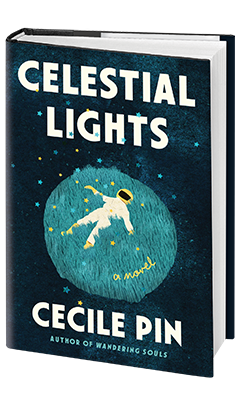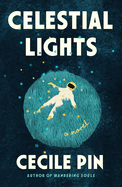Celestial Lights
by Cecile Pin
Curiosity may be fatal to cats, but for humans, the calculus is considerably more nuanced. There are pluses and minuses to exploration. What is gained and what is lost? One person confronting that question is Oliver Ines, born in an English village at roughly the same moment when the space shuttle Challenger exploded, a tragedy that may have been a factor in his decision to become an astronaut. The instinct to explore and the repercussions when that ambition goes too far provide the dramatic tension in Celestial Lights, an elegant novel by London-based French author Cecile Pin.
Some works of fiction can crush readers with their philosophical heft. Others trip lightly over their themes and are richer for it. Pin's story, which starts in 1986 and concludes in the near future, is in the latter category. This seemingly simple tale of a young man tantalized by ambition to the point of risking family stability is the good kind of exploration: a meaningful journey that gains power as it progresses toward its heartrending conclusion.
Oliver, known to everyone as Ollie, may have had a portentous beginning to life--his skin had a short-lived "icy blue hue" at birth--but his childhood is more pleasant. His mother is a French teacher. His father likes to renovate old cars. In 1995, at age nine, Ollie is helping his dad fix a 1960s Mini in their garage when his mum asks him to deliver plums to a village neighbor. That's where he meets Philly, a girl his age and the neighbor's niece, with eyes that were "a colour I'd never seen before--a mix of brown and green and gold." Ollie is smitten.
He and Philly begin hanging out together. She invites him to sit with her under the sycamore tree in her aunt's yard and hunt for New Forest cicadas, the only such species in Britain. The cicadas grow underground for almost 10 years, Philly explains, before rising to lay their eggs--a nice bit of foreshadowing, as readers discover. Thus begins one of Ollie's earliest explorations. Another is when he and Philly go for a walk, and he suggests they cross a forbidden area as a shortcut, "tangible proof that I was brave." Philly sees it as trespassing, "a reckless, pointless act." This, Ollie notes, was "a harbinger of all that was to come."
He's right, as Pin dramatizes in a series of deftly sketched scenes. Ollie and Philly lose touch until Ollie attends university to study engineering and complete a master's thesis on nuclear reactors. A chance encounter reunites him with Philly, who is working toward a PhD in biology and will eventually work for an ecology research group in Edinburgh. They fall in love and soon marry. Ever the natural explorer, however, Ollie has enlisted in the navy, and spends several years working on submarines, including a stint on a ballistic submarine carrying Britain's nuclear deterrent, and is often away from home.
As Pin poignantly dramatizes, Ollie may love his family, but what truly motivates him is space travel. He becomes fascinated by a mission to Mars known as EROS. Later, he follows the voyage of Pegasus, a spacecraft that was to spend 700 days on another Mars journey and was financed by Mark Massey, a billionaire who runs a private company called NovaTech. By the time Ollie is in his 30s, he has become an astronaut of considerable renown. Impressed by his accomplishments, Massey tracks him down and offers him a unique opportunity: apply for NovaTech's astronaut training program, where the company is preparing for a mission to Europa, the icy moon closest to Jupiter, to find out if there's an ocean under its crust that can sustain life. The catch? The mission will last for 10 years--the same amount of time the New Forest cicadas of his childhood need to rise to the surface. Ollie would be the first to walk on Europa. But he'd have to abandon Philly, and their six-year-old son, for a decade. It's no spoiler to say that he takes the challenge.
Pin's writing is especially imaginative once the action moves to outer space. She memorably describes the odd sensations of being on the International Space Station, "the hum of our suits' fans" during spacewalks, the "whole capsule shaking" on an earlier voyage's return to Earth, and more. Interspersed throughout this intriguing novel are excerpts from Commander Oliver Ines's log, a mix of humdrum and tension (Talos, Day 1714. I'm not sure what happened. I'm not sure.) The mystery lies in what happens during that mission, and how a decade in outer space affects Ollie, his family, the NovaTech space program, and Ollie's fellow astronauts.
Central to all of this is of course Ollie, who goes from a childhood with glow-in-the-dark galaxy wallpaper in his bedroom to an adulthood navigating questions of faith, responsibility, the environmental costs of exploration, and the quicksand one can step into when one's priorities are misaligned. That's a tough literary feat to pull off, and Pin does it exceedingly well in this inventive, sincere work. --Michael Magras








